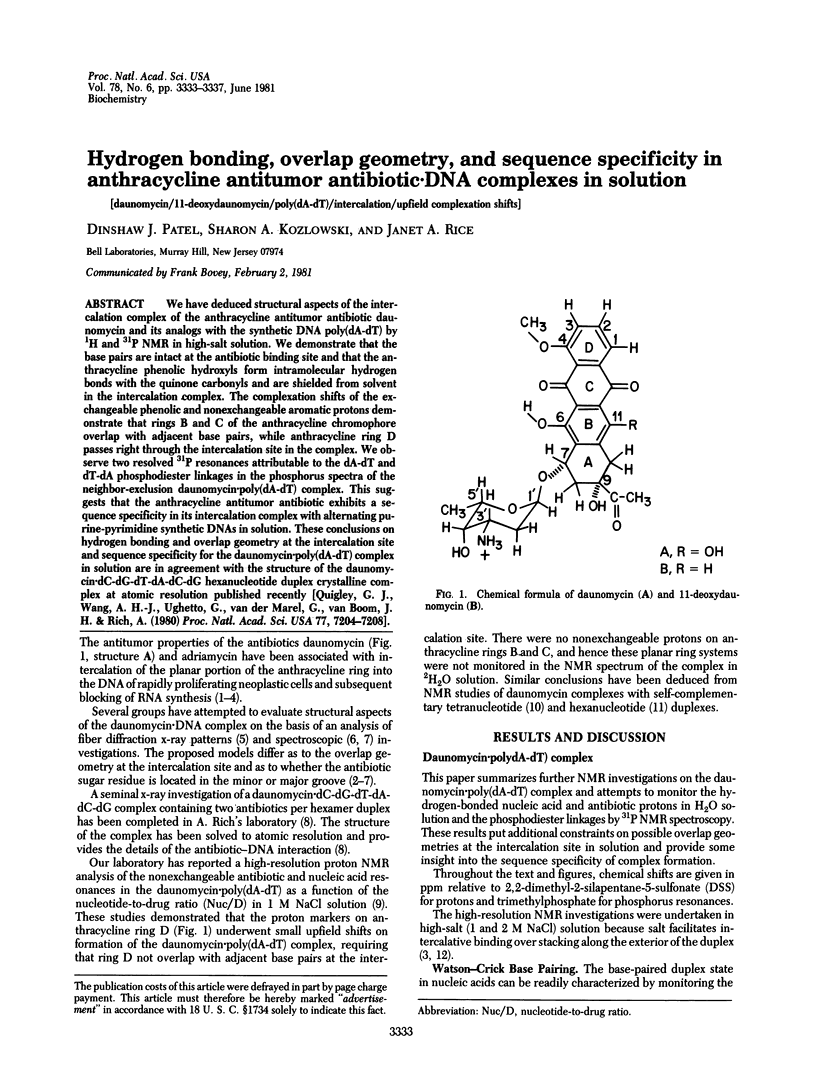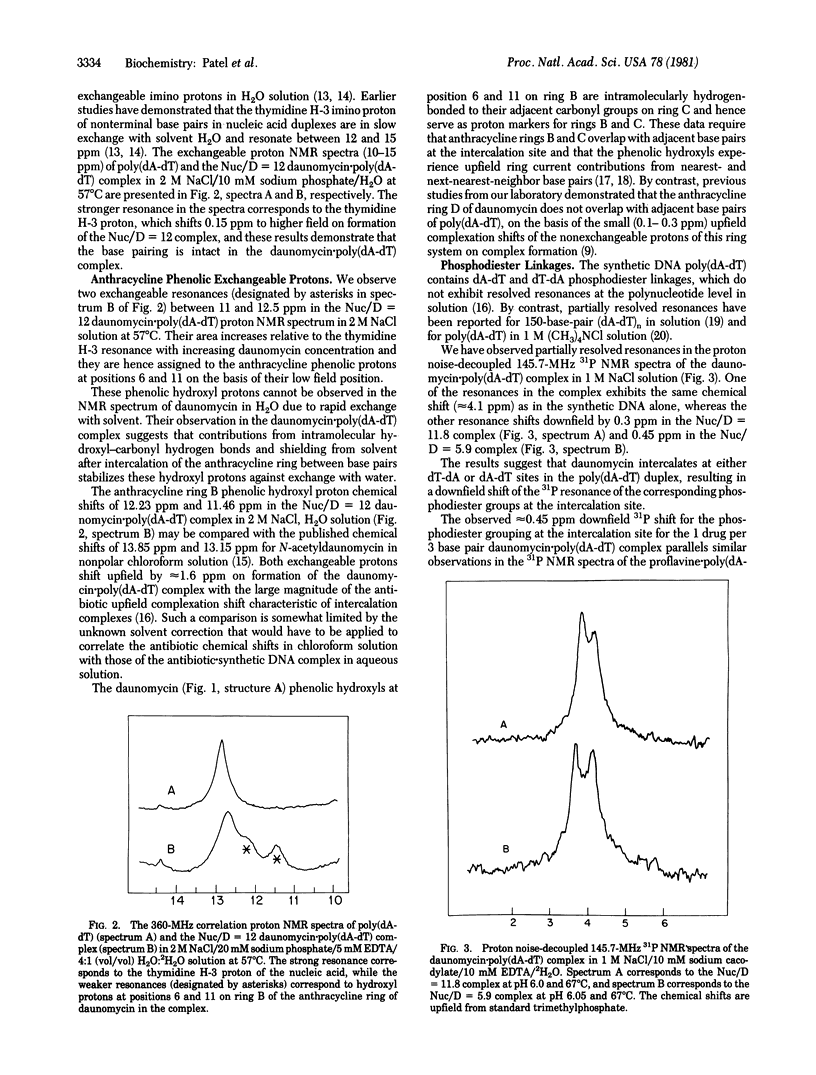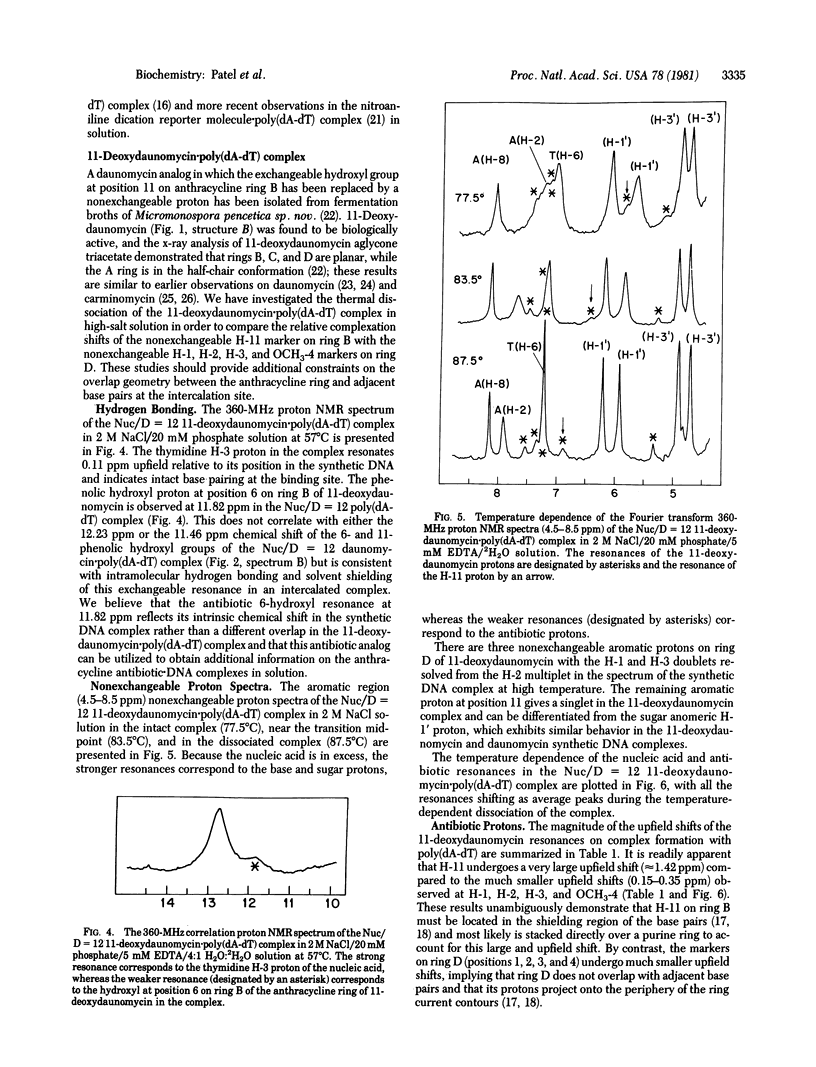Abstract
We have deduced structural aspects of the intercalation complex of the anthracycline antitumor antibiotic daunomycin and its analogs with the synthetic DNA poly(dA-dT) by 1H and 31P NMR in high-salt solution. We demonstrate that the base pairs are intact at the antibiotic binding site and that the anthracycline phenolic hydroxyls form intramolecular hydrogen bonds with the quinone carbonyls and are shielded from solvent in the intercalation complex. The complexation shifts of the exchangeable phenolic and nonexchangeable aromatic protons demonstrate that rings B and C of the anthracycline chromophore overlap with adjacent base pairs, while anthracycline ring D passes right through the intercalation site in the complex. We observe two resolved 31P resonances attributable to the dA-dT and dT-dA phosphodiester linkages in the phosphorus spectra of the neighbor-exclusion daunomycin.poly(dA-dT) complex. This suggests that the anthracycline antitumor antibiotic exhibits a sequence specificity in its intercalation complex with alternating purine-pyrimidine synthetic DNAs in solution. These conclusions on hydrogen bonding and overlap geometry at the intercalation site and sequence specificity for the daunomycin.poly(dA-dT) complex in solution are in agreement with the structure of the daunomycin.dC-dG-dT-dA-dC-dG hexanucleotide duplex crystalline complex at atomic resolution published recently [Quigley, G. J., Wang, A. H.-J., Ughetto, G., van der Marel, G., van Boom, J. H. & Rich, A. (1980) Proc. Natl. Acad. Sci. USA 77, 7204-7208].
Full text
PDF




Selected References
These references are in PubMed. This may not be the complete list of references from this article.
- Angiuli R., Foresti E., Riva di Sanseverino L., Isaacs N. W., Kennard O., Motherwell W. D., Wampler D. L., Arcamone F. Structure of daunomycin; x-ray analysis of N-Br-acetyl-daunomycin solvate. Nat New Biol. 1971 Nov 17;234(46):78–80. doi: 10.1038/newbio234078a0. [DOI] [PubMed] [Google Scholar]
- Arcamone F., Cassinelli G., Franceschi G., Orezzi P., Mondelli R. The total absolute configuration of daunomycin. Tetrahedron Lett. 1968 Jun;(30):3353–3356. doi: 10.1016/s0040-4039(00)89490-3. [DOI] [PubMed] [Google Scholar]
- Arter D. B., Schmidt P. G. Ring current shielding effects in nucleic acid double helices. Nucleic Acids Res. 1976 Jun;3(6):1437–1447. doi: 10.1093/nar/3.6.1437. [DOI] [PMC free article] [PubMed] [Google Scholar]
- Brown J. R. Adriamycin and related anthracycline antibiotics. Prog Med Chem. 1978;15:125–164. doi: 10.1016/s0079-6468(08)70255-8. [DOI] [PubMed] [Google Scholar]
- Gabbay E. J., Grier D., Fingerle R. E., Reimer R., Levy R., Pearce S. W., Wilson W. D. Interaction specificity of the anthracyclines with deoxyribonucleic acid. Biochemistry. 1976 May 18;15(10):2062–2070. doi: 10.1021/bi00655a006. [DOI] [PubMed] [Google Scholar]
- Giessner-Prettre C., Pullman B., Borer P. N., Kan L. S., Ts'o P. O. Ring-current effects in the Nmr of nucleic acids: a graphical approach. Biopolymers. 1976 Nov;15(11):2277–2286. doi: 10.1002/bip.1976.360151114. [DOI] [PubMed] [Google Scholar]
- Kearns D. R., Patel D. J., Shulman R. G. High resolution nuclear magnetic resonance studies of hydrogen bonded protons of tRNA in water. Nature. 1971 Jan 29;229(5283):338–339. doi: 10.1038/229338a0. [DOI] [PubMed] [Google Scholar]
- Marky L. A., Patel D., Breslauer K. J. Effect of tetramethylammonium ion on the helix-to-coil transition of poly(deoxyadenylylthymidine): a nuclear magnetic resonance and calorimetric investigation. Biochemistry. 1981 Mar 17;20(6):1427–1431. doi: 10.1021/bi00509a004. [DOI] [PubMed] [Google Scholar]
- Neidle S., Taylor G. Nucleic acid binding drugs. Part IV. The crystal structure of the anti-cancer agent daunomycin. Biochim Biophys Acta. 1977 Dec 14;479(4):450–459. doi: 10.1016/0005-2787(77)90038-7. [DOI] [PubMed] [Google Scholar]
- Patel D. J., Canuel L. L. Anthracycline antitumor antibiotic nucleic-acid interactions. Structural aspects of the daunomycin poly(dA-dT) complex in solution. Eur J Biochem. 1978 Oct;90(2):247–254. doi: 10.1111/j.1432-1033.1978.tb12597.x. [DOI] [PubMed] [Google Scholar]
- Patel D. J., Canuel L. L. Biphasic helix-coil transition of the ethidium bromide-poly (dA-dT) and the propidium diiodide - poly (dA-dT) complexes. Stabilization of base-pair regions centered about the intercalation site. Biopolymers. 1977 Apr;16(4):857–873. doi: 10.1002/bip.1977.360160410. [DOI] [PubMed] [Google Scholar]
- Patel D. J., Gabbay E. J. Nitroaniline diamine.poly(dA-dT) complexes: 1H and 19F NMR parameters for full intercalation of aromatic rings into DNA. Proc Natl Acad Sci U S A. 1981 Mar;78(3):1351–1355. doi: 10.1073/pnas.78.3.1351. [DOI] [PMC free article] [PubMed] [Google Scholar]
- Patel D. J. Mutagen-nucleic acid complexes at the polynucleotide duplex level in solution: intercalation of proflavine into poly(dA-dT) and the melting transition of the complex. Biopolymers. 1977 Dec;16(12):2739–2754. doi: 10.1002/bip.1977.360161212. [DOI] [PubMed] [Google Scholar]
- Pettit G. R., Einck J. J., Herald C. L., Ode R. H., Von Dreele R. B., Brown P., Brazhnikova M. G., Gause G. F. Letter: The structure of carminomycin I. J Am Chem Soc. 1975 Dec 10;97(25):7387–7388. doi: 10.1021/ja00858a036. [DOI] [PubMed] [Google Scholar]
- Phillips D. R., Roberts G. C. Proton nuclear magnetic resonance study of the self-complementary hexanucleotide d(pTpA)3 and its interaction with daunomycin. Biochemistry. 1980 Oct 14;19(21):4795–4801. doi: 10.1021/bi00562a013. [DOI] [PubMed] [Google Scholar]
- Pigram W. J., Fuller W., Hamilton L. D. Stereochemistry of intercalation: interaction of daunomycin with DNA. Nat New Biol. 1972 Jan 5;235(53):17–19. doi: 10.1038/newbio235017a0. [DOI] [PubMed] [Google Scholar]
- Quigley G. J., Wang A. H., Ughetto G., van der Marel G., van Boom J. H., Rich A. Molecular structure of an anticancer drug-DNA complex: daunomycin plus d(CpGpTpApCpG). Proc Natl Acad Sci U S A. 1980 Dec;77(12):7204–7208. doi: 10.1073/pnas.77.12.7204. [DOI] [PMC free article] [PubMed] [Google Scholar]
- Shindo H., Simpson R. T., Cohen J. S. An alternating conformation characterizes the phosphodiester backbone of poly(dA-dT) in solution. J Biol Chem. 1979 Sep 10;254(17):8125–8128. [PubMed] [Google Scholar]
- Wani M. C., Taylor H. L., Wall M. E., McPhail A. T., Onan K. D. Letter: Antitumor agents. XIII. Isolation and absolute configuration of carminomycin I from Streptosporangium sp. J Am Chem Soc. 1975 Oct 1;97(20):5955–5956. doi: 10.1021/ja00853a073. [DOI] [PubMed] [Google Scholar]
- Zunino F., Gambetta R., DiMarco A., Luoni G., Zaccara A. Effects of the stereochemical configuration on the interaction of some daunomycin derivatives with DNA. Biochem Biophys Res Commun. 1976 Apr 5;69(3):744–750. doi: 10.1016/0006-291x(76)90938-4. [DOI] [PubMed] [Google Scholar]


